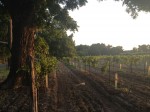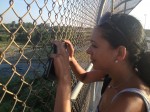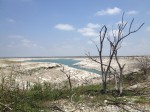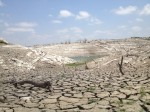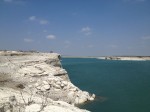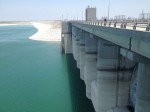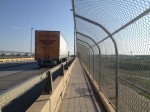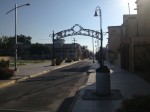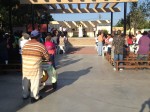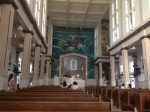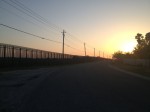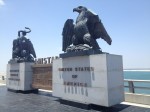It was hard for Lupita and I to leave Eagle Pass.
We had only spent one night there and there was so much more to see.
But our trip along the border needed to continue.
We took U.S. Highway 277 North, a Hill Country Highway that hugs the Rio Grande River.
It’s only a one-hour trip but we drove through the towns of Elm Creek and Quemado as well as pecan farms and ranches.
The further west we got, the rockier and more sparsely vegetated the hills became.
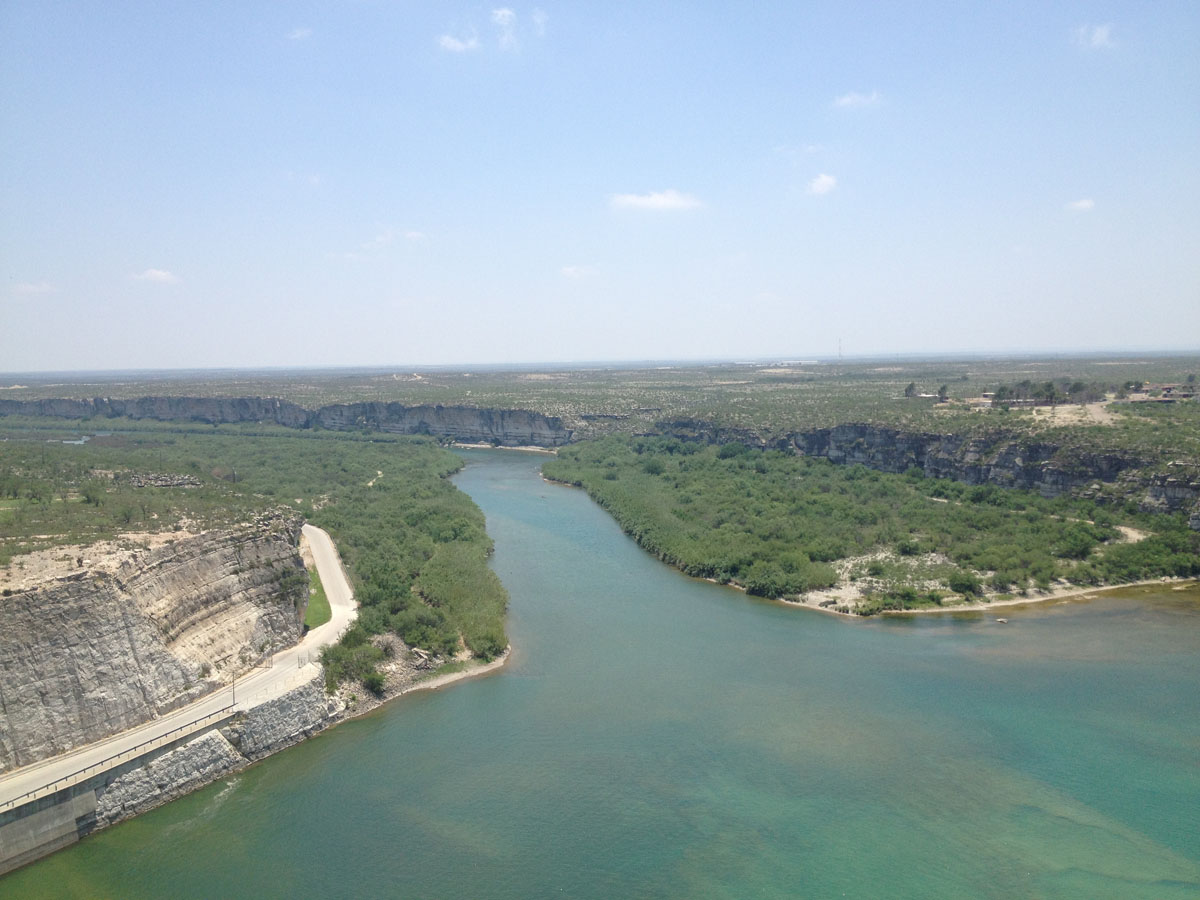
The beautiful Rio Grande River at the foot of Amistad Dam. (Sergio Chapa/Borderzine.com)
Before we knew it, we had arrived at the gates of Laughlin Air force Base and the city of Del Rio, Texas.
Neither Lupita nor I had been to Del Rio before.
We were both excited to be in the border town of 36,000 people.
It was already late in the afternoon, so we headed straight for the Del Rio-Ciudad Acuña International Bridge.
Del Rio/Ciudad Acuna Intl Bridge
Unlike other border cities, the international bridge in Del Rio does not connect with downtown but rather is located on the edge of the city.
Parking our car on the American side of the bridge, we walked across the border to Mexico.
We didn’t mind the summer heat as we walked across the half-mile bridge, one of the longest along the Texas/Mexico border.
Just past the border fence is a no-man’s land of farm fields on the American side of the border.
An occasional 18-wheeler or car drove past us indifferently as we walked south in the summer heat.
Our reward was being able to stop and see the Rio Grande River.
In the Del Rio area, the Rio Grande River is cool, clear and shallow alternating color from emerald green to sapphire blue.
We marveled at the sight, never imagining that the Rio Grande River could be so clean and inviting.
There are no parks on the American side of the river but there is a large one next to the bridge on the Mexican side of border.
Young men played soccer and children played in the clean water of the river.
Ciudad Acuña, Coahuila
Like Piedras Negras, Ciudad Acuña is part of the “Frontera Blanca” or “White Border.”
Known for people of deep Catholic faith, the region was always considered one of the most peaceful along the border where the motto went “No Pasa Nada” or “Nothing Ever Happens.”
Founded in 1912, trouble seems to be below the surface in Ciudad Acuña.
The hackers collective Anonymous had set up a cell in Ciudad Acuña to expose corruption and the exploits of the Zetas drug cartel.
Lupita and I didn’t see a single piece of litter along the stone sidewalk-lined streets but we could both sense something was wrong.
Just a few feet walking into the city, we walked through a strip of bars and nightclubs that had been closed for months or maybe even years.
The only one that was open was a gay bar that offered a drag show a couple nights of the week.
Walking further through the town, we saw shopping centers that once greeted large numbers of American tourists but are all now closed.
In the city’s main plaza, we found families peacefully enjoying the afternoon buying snacks and popsicles from vendors.
People of Faith
A non-denominational Christian group was holding a music and prayer service with more than a 100 people were participating.
We felt relieved because it gave us a sense of something wholesome after seeing so many things that made us uncomfortable.
One side effect of the drug war is that non-denominational Christian sects have sprouted like mushrooms along the Mexican side of the border.
It’s a battle for souls in Mexico where many of the converts believe the Catholic Church is too weak, corrupt or impotent to stop the sin and the violence around them.
These new Christian groups are claiming converts among prostitutes, drug addicts and even drug cartel gunmen but their theology and beliefs can sometimes be outside the mainstream.
Just across the street from the plaza is the Santa Maria de Guadalupe Catholic Church, a cubists and modern building adorned with three statues of angels.
The main angel is an icon for the city. Many say if you haven’t seen it, then you really haven’t been to Ciudad Acuña.
We found at least half a dozen parishioners inside for afternoon mass.
The experience was very rewarding but a homeless man quickly latched on to us and kept following us.
We gave him the slip but walking back to the bridge, a pick up with a trailer full of coffins passed us and made a delivery a funeral home.
It was a reminder that death is constant companion along the Mexican side of the border.
Del Rio
It was getting closer to sunset but we still had time to explore Del Rio.
We drove the old shops of downtown and found ourselves in the city’s Southside.
Broad streets with large and beautiful homes were lined with large pecan trees whose branches created a canopy over the road.
It was like being in fictional town of Mayberry from “The Andy Griffith Show” or on the 1950s TV show “Leave It To Beaver.”
Society’s problems seemed so far away in wholesome slice of Americana, a contrast to what we had seen just earlier in Mexico.
Lupita and I were surprised to find a historic vineyard near the border fence where we watched the sun set.
After doing so much exploring, we finally remembered that we needed to eat.
Jitra Thai Cuisine offered a rare surprise on our trip: an exotic meal.
Founded by a Thai woman brought to the United State through her Laughlin Air Force base husband, the restaurant has good food and spicy chicken wings.
Lake Amistad
In the morning, we stopped to meet Del Rio News-Herald editor Diana “Didi” Fuentes for breakfast.
We stopped at Chinto’s, a Tex-Mex place that offers generous portions for breakfast and features a wall of colorful Mexican wrestling masks.
Our morning coffee chat included talking about how much we had seen the border change over the years.
But there was no time for rest as Lupita and I continued west along U.S. Highway 90.
Just 12 miles out of Del Rio, we found ourselves at Lake Amistad National Recreation Area.
The impact of the ongoing Texas drought was immediately noticeable.
Bare trees lined and sparse grass lined the white, sun-bleached limestone cliffs.
The 64,900-acre reservoir was far below its capacity but water was still cold and an inviting sapphire blue in color.
It was a marvel and a reminder about what a beautiful place the border can be.
Our next stop was Amistad Dam International Border crossing.
Amistad Dam Intl Crossing
Built in 1969, the dam also serves as an international border crossing.
There’s a small parking lot a top the dam on the American side of the international boundary line.
We walked around and snapped several photos from the top of the engineering marvel.
At the foot of the dam, the water of the Rio Grande River has a green color looking both cool and inviting on a hot summer day.
Lupita and I had the dam to ourselves for a long time until a family from Ciudad Acuña showed up.
We exchanged pleasantries but went back through customs to go to a park and go swimming.
The 60-degree water felt so good on a 100-degree summer day.
We watched a cargo train cross the rail bridge over the lake while cars whizzed by on a separate bridge for U.S. Highway 90.
Seminole Canyon
Both of us were completely dry by the time we made it back to the car and continued our journey west.
We made a stop at Seminole Canyon State Park, a historic site along one of the arms of the Rio Grande River.
American Indians first made the rolling hills their home during the late ice age hunting mammoths, bison, camels and prehistoric horses.
The climate was much more temperate back then but changed into the arid landscape it is today.
Rock paintings can still be found in the cliffs of the park.
Guided tours are offered twice a day but during the summer there is only one tour in the mornings due to oppressive heat.
We made it just as the visitor’s center was closing but got to explore the park.
It was immediately clear that the geography and plant life were changing on us.
The cedar and oak trees of the Hill Country were now becoming thorn bushes, cactus and ocotillos, whose thin cactus arms reach into the sky.
It felt like the gateway to the American West.
- A vineyard just south of downtown Del Rio. (Sergio Chapa/Borderzine.com)
- Jitra Thai Cuisine offered a surprising dinner in Del Rio. (Sergio Chapa/Borderzine.com)
- Stopping for a picture along the international bridge. (Sergio Chapa/Borderzine.com)
- Rio Grande River is so clean in Del Rio that you can see to the bottom. (Sergio Chapa/Borderzine.com)
- Chinto’s Super Taco has collection of Mexican wrestling masks. (Sergio Chapa/Borderzine.com)
- Lupita takes a picture of the Rio Grande River. (Sergio Chapa/Borderzine.com)
- Playing with an interactive map at the Lake Amistad National Recreation Area visitor’s center. (Sergio Chapa/Borderzine.com)
- Nowhere is the current drought more devastating than Lake Amistad, an international reservoir just west of Del Rio. (Sergio Chapa/Borderzine.com)
- Nowhere is the current drought more devastating than Lake Amistad, an international reservoir just west of Del Rio. (Sergio Chapa/Borderzine.com)
- Nowhere is the current drought more devastating than Lake Amistad, an international reservoir just west of Del Rio. (Sergio Chapa/Borderzine.com)
- Nowhere is the current drought more devastating than Lake Amistad, an international reservoir just west of Del Rio. (Sergio Chapa/Borderzine.com)
- The sapphire blue water of Lake Amistad. (Sergio Chapa/Borderzine.com)
- The international bridge between Del Rio and Ciudad Acuña one of the longest along the border. (Sergio Chapa/Borderzine.com)
- The entrance to Ciudad Acuña was once filled with bars, restaurants and American tourists. (Sergio Chapa/Borderzine.com)
- An old plaza for tourists in downtown Ciudad Acuña now sits empty. (Sergio Chapa/Borderzine.com)
- With legendary newspaper editor Diana “Didi” Fuentes, who now lives in Del Rio. (Sergio Chapa/Borderzine.com)
- With legendary newspaper editor Diana “Didi” Fuentes, who now lives in Del Rio. (Sergio Chapa/Borderzine.com)
- A Christian sect holds an afternoon service in Ciudad Acuña’s main plaza.(Sergio Chapa/Borderzine.com)
- The cathedral in downtown Ciudad Acuña. (Sergio Chapa/Borderzine.com)
- Inside the main cathedral in downtown Ciudad Acuña. (Sergio Chapa/Borderzine.com)
- Sunset along the border fence in Del Rio. (Sergio Chapa/Borderzine.com)
- The beautiful Rio Grande River at the foot of Amistad Dam. (Sergio Chapa/Borderzine.com)
- Amistad Dam also serves as an international border crossing. (Sergio Chapa/Borderzine.com)


